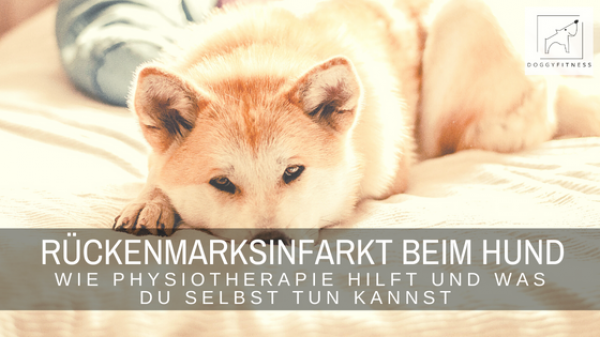The last blog post was already about spinal cord infarction in dogs and its development as well as symptoms. In this article you will get important information about why physiotherapy is so indispensable and which measures help particularly well – and above all which of them can also be taken over by yourself.
Dogs that suffer a spinal cord infarction should definitely be treated with physiotherapy as soon as possible in order to counteract the damage as effectively and intensively as possible. As important as the accompaniment of a physiotherapist is, the intensive cooperation of the dog owner at home is also essential to achieve the best possible progress in rehabilitation.
Therefore, I recommend that you make sure that your physical therapist involves you in the recovery process and gives you options to support your dog with on a daily basis at home. Depending on the situation, these can be massage grips, passive movement exercises or active movement exercises.
But what can physical therapy accomplish in spinal cord infarction?
The therapy goals
- Maintain and improve joint mobility
- Restoration of a normal gait pattern
- Improve and relearn coordination and balance
- Training of perception and sensitivity
- Muscle maintenance and building
- Pain relief/relaxation of overstressed structures due to incorrect movement patterns.
Spinal cord infarction in dogs – the treatment options
There is a wide range of therapies that can be used to help a dog with a spinal cord infarction. The choice and composition of the types of therapy is always individually dependent on the patient concerned.
Massage – This can relieve tension and pain caused by incorrect stress. Massage handles can also be performed by the dog owner after instruction.
Brush/ -hedgehog ball massage – Sensitivity and perception can be improved with a brush massage or also stimulation by a hedgehog ball.
Stroking the spaces between the toes and massaging the paw pads – This trains nerve conduction and strengthens perception. You can also do this as a dog owner.
Passive movement – By means of passive movement exercises, joint mobility can be maintained and improved.
Acupuncture – Acupuncture – by needles or soft laser can also be used to support rehab.
Physical Therapies – Depending on the physical therapist’s equipment, physical therapies such as laser or electrotherapy may also be used.
Training in the underwater treadmill – In the underwater treadmill you can gently train healthy movements and at the same time promote mobility and musculature.
Manual lymphatic drainage – Manual lymphatic drainage is excellent for reducing swelling. This removes the edema. Pressure is relieved and the nerves in the affected segment can recover. And the metabolism is improved.
Movement training
Exercise training is a very important part of physical therapy and is also an important factor in spinal cord infarction. You can also do exercises as instructed with your dog at home to help with rehab. However, please be sure to have a professional instruct you and do not go looking for exercises on your own. In case of doubt, you will harm your dog more than you will help him. Isometric exercises, balance training, etc. are excellent for spinal cord infarction.
Basically, recovery requires a lot of patience and the road is long for you and your dog. But you should not give up at all, because if you continuously keep at it, your dog has a chance to recover very well.
In the next article, I’ll put together helpful tips on how to support your dog in everyday life if he has a spinal cord infarction.
All the love, Tina
Spinal cord infarction in dog Spinal cord infarction in dog Spinal cord infarction in dog Spinal cord infarction in dog Spinal cord infarction in dog Spinal cord infarction in dog
Dieser Beitrag ist auch verfügbar auf:
Français (French)
Deutsch (German)
Español (Spanish)
















